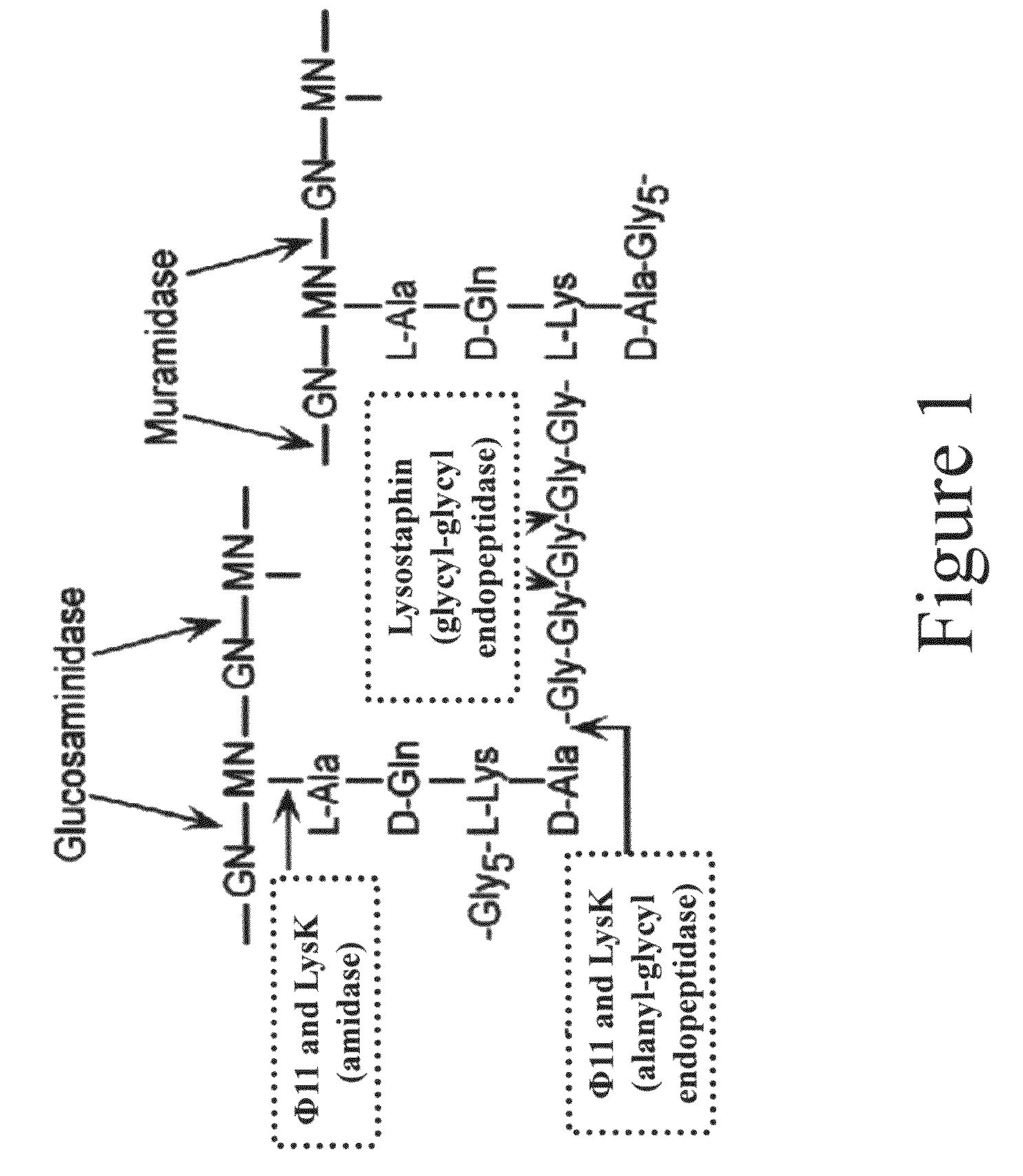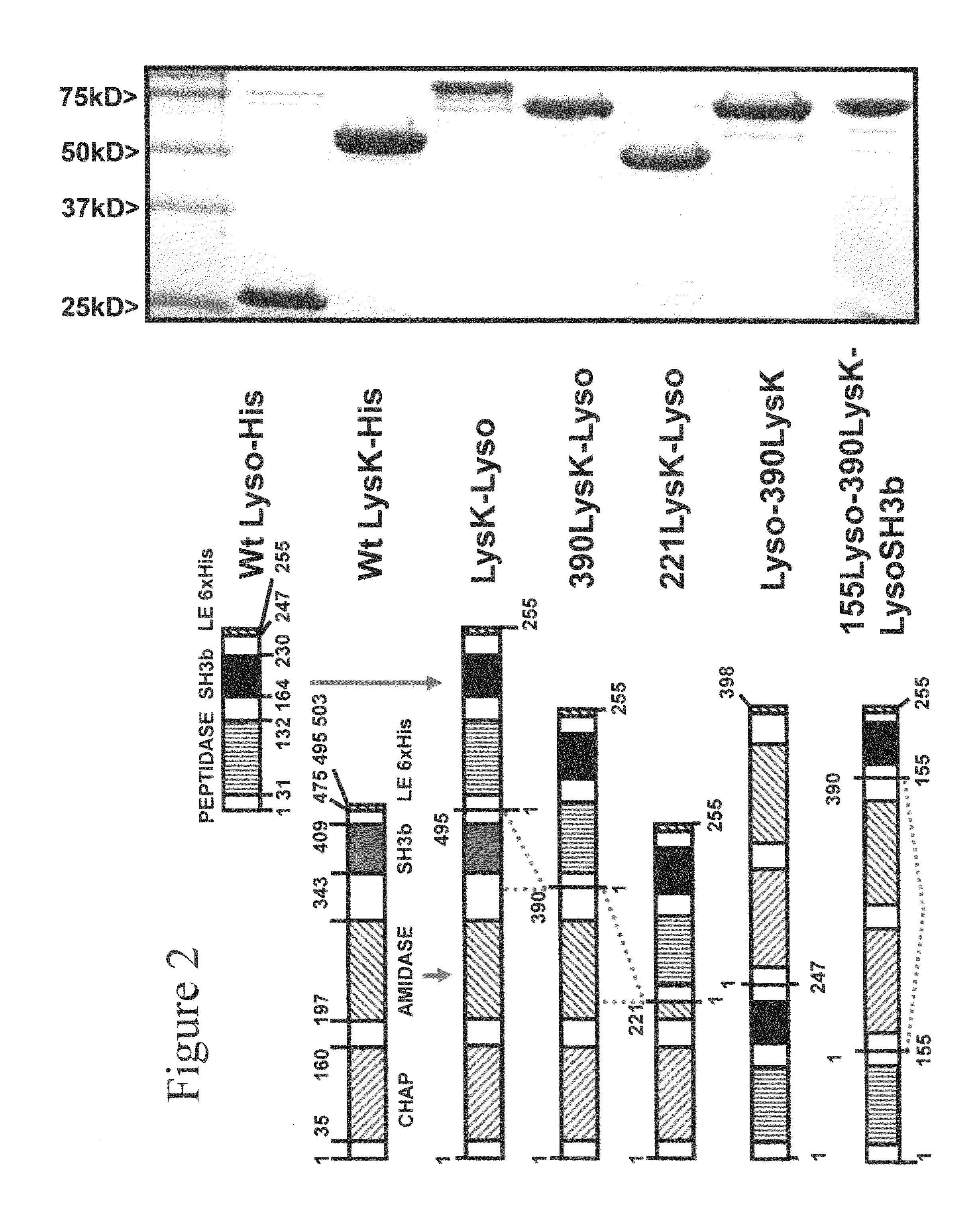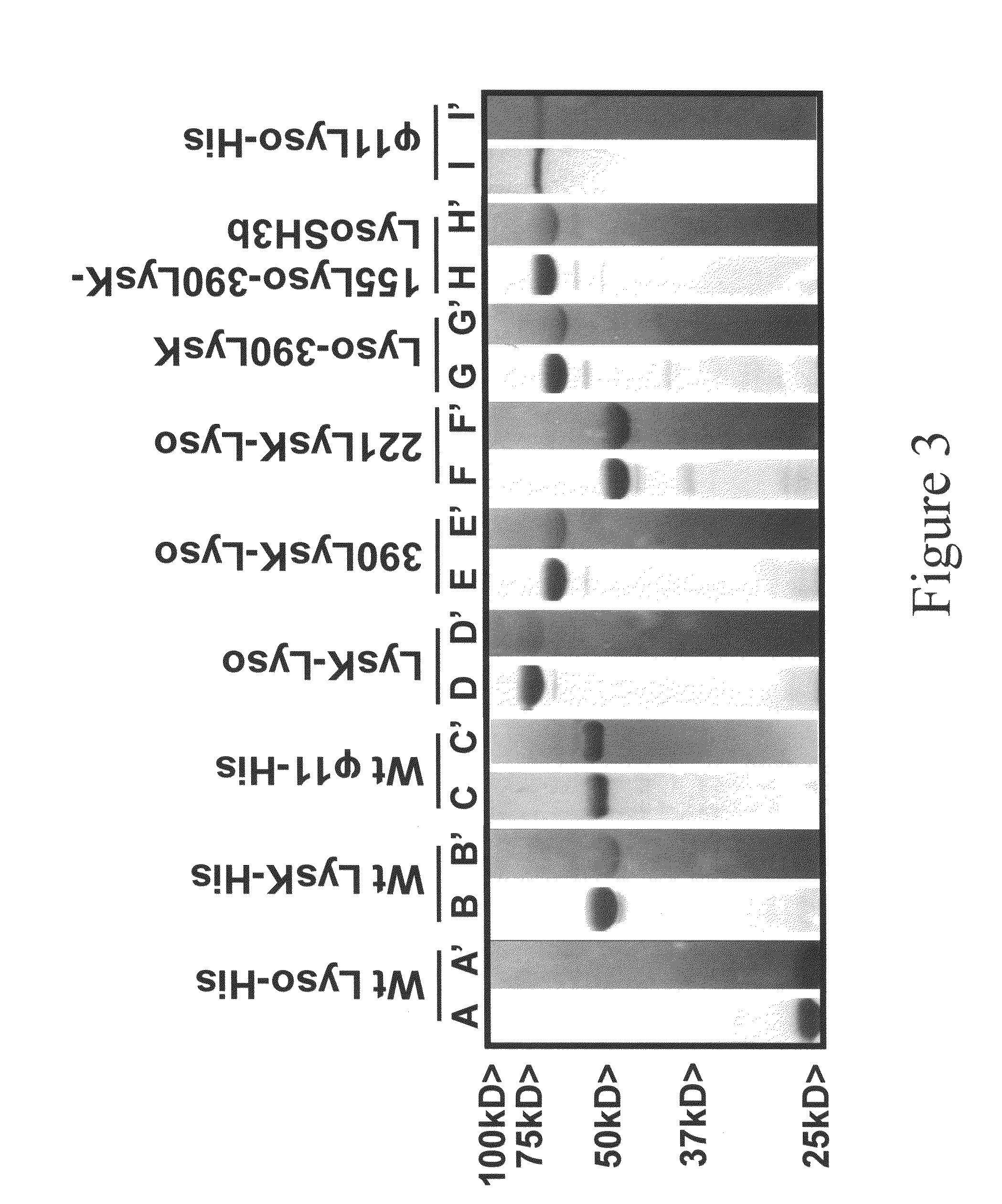Triple acting antimicrobials that are refractory to resistance development
a technology of glycyl endopeptidase and triple acting antimicrobials, which is applied in the direction of recombinant dna-technology, enzyme stabilisation, peptide/protein ingredients, etc., can solve the problem of interfering with the ability of glycyl endopeptidase to recognize and cleave, limited treatment options of topical antimicrobial agents, and insufficient control strategies. to achieve the effect of effectively ly
- Summary
- Abstract
- Description
- Claims
- Application Information
AI Technical Summary
Benefits of technology
Problems solved by technology
Method used
Image
Examples
example 1
Plasmids, Constructs and Strains
[0080]The LysK cDNA was kindly provided by Paul Ross (O'Flaherty et al. 2005. J. Bacteriol. 187: 7161-7164). Phage K genomic sequence has been published (AY176327) and the LysK protein sequence is also available (AA047477.2) through Genbank. Inducible vector constructs were created in pET21a (EMD Biosciences, San Diego, Calif.) for introduction of a C-terminal His-tag. For cloning into pET21a, the LysK sequences were amplified with primers LysK Nde F (5′-GAGAAATTACATATGGCTAAG ACTC-3′; SEQ ID NO:17) and LysK Xho R (5′-ATGGTGATGCTCGAGTTTGAATACTC C-3′; SEQ ID NO:18, Table 1) (engineered restriction enzyme sites are underlined). [All primers utilized in construct preparation are described in Table I.] PCR subcloning is performed when PCR products are gel purified and digested appropriately with Restriction Enzymes (RE) that recognize and cleave at the engineered sites. The resultant gene fragments are purified over a Micro Bio Spin P30 desalting column (B...
example 2
Protein Purification
[0092]E. coli cultures harboring pET21a derived Lysostaphin expression vectors were grown under ampicillin selection to mid log phase (OD600 nm of 0.4-0.6), chilled on ice for 30 min, induced with 1 mM IPTG (isopropyl-beta-D-thiogalactopyranoside), and incubated at 19° C. with shaking for 18 h. E. coli harvested from 100 ml cultures were suspended in 2 ml lysis buffer (50 mM NaH2PO4, 300 mM NaCl, 10 mM imidazole, pH 8), sonicated on ice for 15×5 sec pulses separated by 15 sec. rests, and centrifuged at 11,000×g for 20 minutes at 4° C. The cleared lysate was transferred to microfuge tubes and centrifuged at 16,000×g for 30 min at 4° C. The cleared supernatant was applied to 1 ml Ni-NTA (nickel matrix) in a slurry and mixed gently for 1 hour at 4° C. (Qiagen). The slurry was loaded into a polypropylene column (Qiagen #34964) where wash and elution buffer profiles were empirically determined for the LysK constructs to be 10 ml of 10 mM imidazole, 20 ml of 20 mM imid...
example 3
SDS PAGE and Zymogram
[0093]The purified fusion proteins and Kaleidoscope protein standards (Invitrogen, Carlsbad, Calif.) were analyzed with 15% SDS-PAGE, with or without 300 ml equivalent of mid log phase S. aureus 305 cells (OD600 nm of 0.4-0.6). Gels were prepared and electrophoresed in Tris-Glycine buffer at 100 volts for 1.5 hours in the BioRad Mini-PROTEAN 3 gel apparatus, according to manufacturer's instructions. SDS gels were stained in BioSafe Coomassie stain (BioRad, Hercules, Calif.) for one hour and then rinsed in distilled water overnight. Zymograms were washed in excess water for 1 hour to remove the SDS and incubated at room temperature in water, resulting in areas of clearing in the turbid gel wherever a lytic protein was localized.
[0094]Zymogram analysis was performed with a 50× concentrated suspension of log phase S. aureus cells added to the SDS PAGE gel mixture prior to polymerization. The SDS PAGE and zymogram gels were made identically, loaded with identical sa...
PUM
| Property | Measurement | Unit |
|---|---|---|
| pH | aaaaa | aaaaa |
| concentrations | aaaaa | aaaaa |
| concentrations | aaaaa | aaaaa |
Abstract
Description
Claims
Application Information
 Login to View More
Login to View More - R&D
- Intellectual Property
- Life Sciences
- Materials
- Tech Scout
- Unparalleled Data Quality
- Higher Quality Content
- 60% Fewer Hallucinations
Browse by: Latest US Patents, China's latest patents, Technical Efficacy Thesaurus, Application Domain, Technology Topic, Popular Technical Reports.
© 2025 PatSnap. All rights reserved.Legal|Privacy policy|Modern Slavery Act Transparency Statement|Sitemap|About US| Contact US: help@patsnap.com



